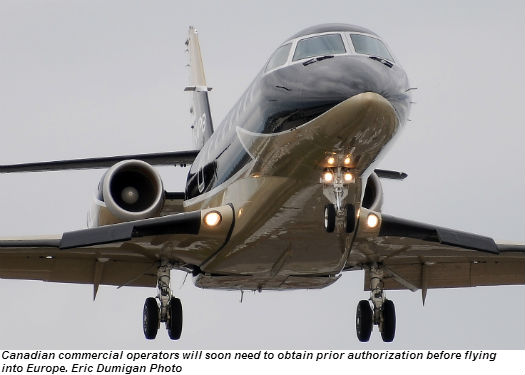Estimated reading time 6 minutes, 27 seconds.
Canadian operators who hold a commercial air operator certificate in accordance with ICAO Annex 6, Part I, will soon need prior authorization before flying into Europe. Experts on European Aviation Safety Agency (EASA) regulations say operators would be wise to start preparing for the incoming Third Country Operator (Part-TCO) rules, which are expected to enter into force next year.
In July 2013, the European Commission adopted a proposal for the authorization of Third Country Operators (TCO) as a means of providing a “single, proportionate and risk-based safety assessment performed by EASA.”
Currently making its way through the European legislative procedure, Part-TCO is expected to enter into force early in 2014. At that point, there will be a 24-month transitional phase-in period – but foreign commercial operators who intend to fly into Europe must submit a TCO application within the first six months after Part-TCO enters into force.
“If there is even a possibility that you will fly into Europe, we recommend that you register right from the beginning,” said Joel Hencks, managing director of AeroEx, a Swiss-based organization established in 2006 to offer consulting and EASA compliance services to aviation-related companies.
Hencks, who has extensive experience as an airline transport pilot as well as in the field of compliance and safety management, told Canadian Skies that EASA’s incoming Part-TCO rules have the potential to disrupt Canadian commercial flights into the 32 EASA member states, which includes members of the European Union (EU), as well as Switzerland, Liechtenstein, Norway, Iceland and some overseas territories belonging to EU members.
“These rules represent an authorization process,” he explained. “Before flying into Europe, operators will need to get authorization from EASA. It’s a process similar to Part 129 in the U.S., although with some differences. Every commercial operator holding an AOC after the effective date of the rule will need to apply for this authorization.”
How to Apply
EASA has designed the Part-TCO authorization process to be fairly simple, and – for now – it will be free of charge. Commercial operators will need to complete an online application at least 30 days in advance of their planned flight to Europe. Hencks stressed that the earlier the application is filed, the better. In the case of on-demand charter operations, for example, most flights are not booked with 30 days’ notice, so obtaining prior approval will be critical. (Part-TCO regulations do contain some leeway for an ad hoc flight, but only one is allowed in a 24-month period.)
“The application process will come online as soon as the rule is published,” explained Hencks. “Basically, operators will have to send in a copy of their air operator certificate, ops specs, maybe some parts of their operations manual, etc. That’s the first step.”
Once an application is received, EASA will evaluate the operator using a risk-based approach. If the state of registry is fully ICAO-compliant, which Canada is, approvals should be fairly straightforward. A Part-TCO authorization is valid for an unlimited time, as long as the operator remains in compliance with the regulations. Hencks pointed out that the onus is on the operator to inform EASA of any changes to its fleet or operational specs; as well, they must address any shortcomings immediately.
Part-TCO authorization will not be required for flights overflying EASA member states; however, even those who land only for fuel will be subject to the new regulations, meaning they could be greeted with a ramp check upon arrival. During these checks, officials could ask crews to produce documentation on pilot licensing and aircraft airworthiness, and will likely evaluate the safety equipment on board and general condition of the aircraft, among other things, in accordance with ICAO standards. Ramp checks will produce three levels of findings, ranging from a moderate category 1 finding that does not affect an operator’s safety rating, to a category 3 finding that will result in the grounding of the aircraft.
“If you operate without the authorization, and they are monitoring air traffic, there is a high probability a ramp check will be waiting for you upon landing,” said Hencks.
His company, AeroEx, has partnered with Canadian online aviation training provider, TrainingPort.net, and together they will deliver a free web-based Part-TCO awareness lesson by the end of this year. AeroEx also offers operators assistance with the Part-TCO application process, and will help them to comply with any ramp check findings.
“We think that most of the operators that are already coming into the EU should not face important findings,” said Hencks. “But, we know there are some operators that will definitely need assistance.”
He added that there may also be a similar approval process in the future for non-commercial operators flying into Europe, but a time frame for implementation has not been established.
AeroEx may be contacted through the company website,
www.aeroex.eu

